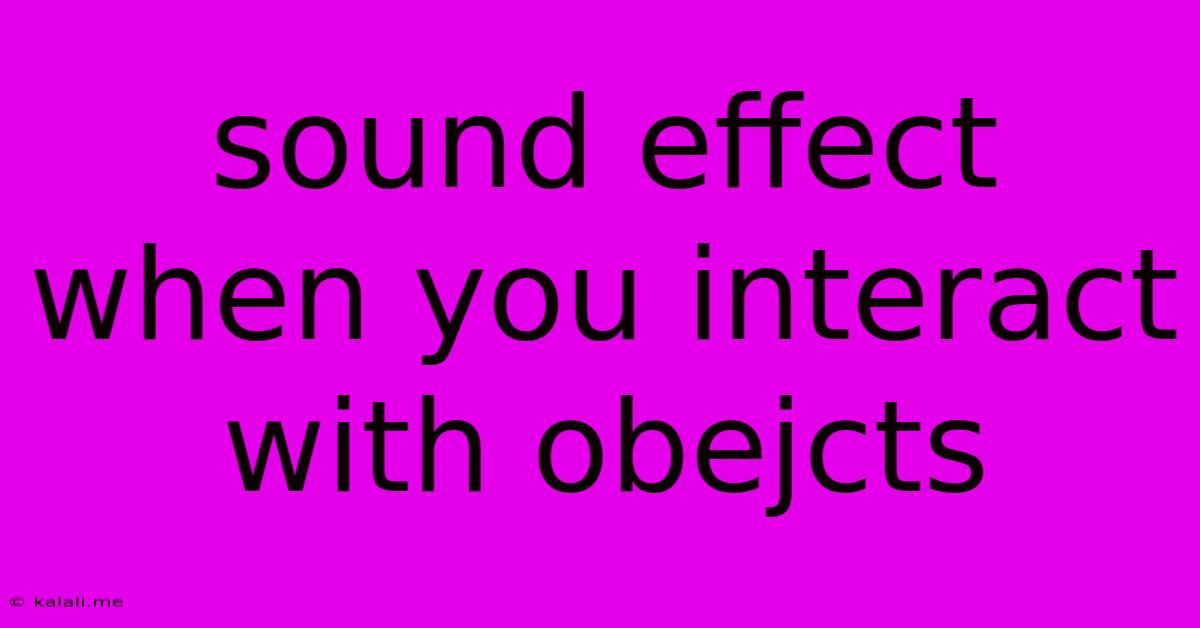Sound Effect When You Interact With Obejcts
Kalali
Jun 05, 2025 · 3 min read

Table of Contents
The Power of Sound Design: Enhancing User Interaction Through Audio Feedback
Meta Description: Discover how strategically implemented sound effects significantly improve user experience by providing clear and satisfying audio feedback during object interactions. Learn about different types of sound design and best practices.
The digital world is increasingly focused on visual experiences, but the power of sound shouldn't be underestimated. Effective sound design plays a crucial role in enhancing user interaction, creating a more immersive and satisfying experience. When you click a button, drag a file, or even select an item in a game, the accompanying sound effect provides crucial feedback, informing the user that their action has been registered. This seemingly small detail significantly impacts usability and overall enjoyment.
This article will delve into the importance of sound effects in user interaction, exploring various types of sounds and best practices for creating effective audio feedback.
Types of Sound Effects for Object Interaction
The sound you choose dramatically impacts the user's perception. Here are some key categories:
-
Confirmation Sounds: These are typically short, positive sounds that acknowledge successful actions. Think of the satisfying "click" when you check a box or the gentle "ding" of a completed task. These sounds are vital for reinforcing positive feedback loops.
-
Error Sounds: These sounds alert users to mistakes. They should be noticeable but not jarring. A short, low-pitched "buzz" or a subtle "error" tone works well, providing immediate feedback without being overly intrusive.
-
Navigation Sounds: These guide users as they navigate interfaces. For example, a soft "whoosh" when moving between screens or a subtle "click" when selecting a menu item can improve intuitiveness.
-
Environmental Sounds: These sounds contribute to the overall atmosphere and immersion, particularly in games or simulations. The subtle creak of a door opening or the rustle of leaves can greatly enhance realism.
-
Mechanical Sounds: These mimic the physical actions of real-world objects. The whirring of a loading screen, the clicking of a gear, or the swipe of a touchscreen provides haptic feedback through audio.
Best Practices for Implementing Sound Effects
Creating effective sound effects requires careful consideration:
-
Clarity and Brevity: Sounds should be clear, concise, and easily distinguishable. Avoid overly long or complex sounds that can become distracting.
-
Contextual Appropriateness: The sound should match the action and the overall tone of the interface. A playful sound might be appropriate for a game, while a more professional sound would suit a business application.
-
Volume and Balance: Sounds should be appropriately loud but not overpowering, blending seamlessly with other audio elements.
-
Consistency: Maintain consistent sound design throughout the application. Using similar sounds for similar actions promotes predictability and ease of use.
-
Accessibility: Consider users with hearing impairments. Provide alternative visual feedback mechanisms to accompany sound effects.
The Impact of Sound Design on User Experience
Well-designed sound effects contribute to:
-
Improved Usability: Clear audio feedback reduces ambiguity and enhances the overall efficiency of user interaction.
-
Enhanced Engagement: Immersive and engaging sounds create a more enjoyable and memorable user experience.
-
Increased Satisfaction: Positive feedback through sound design reinforces positive user experiences, encouraging continued use.
-
Better Error Prevention: Clear error sounds can prevent users from making mistakes by immediately alerting them to issues.
In conclusion, the strategic use of sound effects is not merely an aesthetic enhancement, but a crucial element of user interface design. By carefully considering the types of sounds, their implementation, and their impact on user experience, developers can create more intuitive, enjoyable, and ultimately successful applications and games. Investing time and resources in this area significantly improves the overall quality of the interaction.
Latest Posts
Latest Posts
-
Wood Filler For Hardwood Floor Gaps
Jun 06, 2025
-
A Spark Plug With Too Cold A Heat Range Will
Jun 06, 2025
-
Can I Paint A Toilet Bowl
Jun 06, 2025
-
Dragon Age Inquisition How To Save Everyone In Haven
Jun 06, 2025
-
Can You Play Munchkin With 2 Players
Jun 06, 2025
Related Post
Thank you for visiting our website which covers about Sound Effect When You Interact With Obejcts . We hope the information provided has been useful to you. Feel free to contact us if you have any questions or need further assistance. See you next time and don't miss to bookmark.